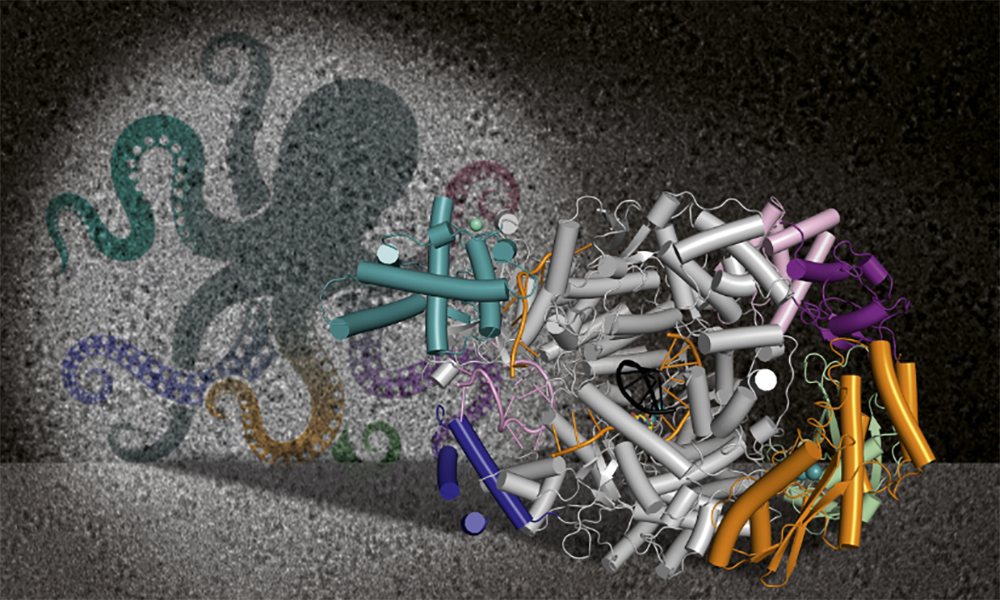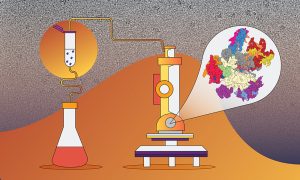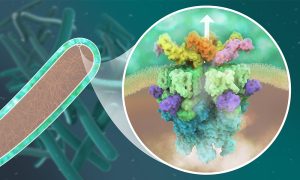
Using structural biology to investigate molecular machinery
EMBL structural biologists continue to improve understanding of the mechanisms of life.

Structural biologists at EMBL – particularly at Grenoble, Hamburg, and Heidelberg – focus on understanding the nature and role of specific molecules, the building blocks of life. Key to this process is figuring out the three-dimensional shape of molecules, which, like a fingerprint, is unique and holds clues to their function.

Not only does structural biology provide important insights on the mechanisms of life, but it also plays a significant role in developing potential treatments against genetic disorders or infectious diseases.
Among several achievements in 2021, EMBL researchers shed light on a crucial step in RNA splicing, described the structure of the Integrator complex, and characterised a human RNA polymerase enzyme. Additionally, the combination of cryo-electron tomography with advanced software developed by EMBL researchers allowed them to model molecular complexes inside cells at atomic resolution.

Recent structural biology studies have also revealed new opportunities to combat infectious diseases. For example, EMBL researchers determined the detailed structure of a bacterial protein complex critical for tuberculosis infection, which could potentially help scientists develop new vaccines against tuberculosis. In another study, researchers illuminated protein interactions involved in pneumonia, opening the possibility of new drug targets. EMBL scientists were also part of an international collaboration that detailed the functional structure of the octopus-like polymerase of the Lassa virus, which can cause severe haemorrhagic disease.

“Structural biology is important to understand what we are actually looking at. If we know how these viruses work, then we have more ideas on how to tackle them.”
— Maria Rosenthal, Group Leader, Bernhard Nocht Institute for Tropical Medicine, and collaborating with the Cusack Group at EMBL Grenoble on the Lassa virus
Explore more 2021 EMBL structural biology research highlights:
- Capturing snapshots of a crucial step in RNA splicing
- At the core of the Integrator complex | EMBL
- A better look at a human RNA polymerase | EMBL
- Observing the secret life of molecules inside the cell | EMBL
- Structural biology reveals new opportunities to combat tuberculosis | EMBL
- Solving molecular puzzles to find the perfect fit | EMBL
- Wrangling an octopus-like viral replication machine | EMBL
References
Tholen J et al. (2021). Structural basis of branch site recognition by the human spliceosome. Science, 25 November 2021. DOI: 10.1126/science.abm4245
Pfleiderer M, Galej W. (2021). Structure of the catalytic core of the Integrator complex. Molecular Cell, 5 February 2021. DOI: 10.1016/j.molecel.2021.01.005
Girbig et al. (2021). Cryo-EM structures of human RNA polymerase III in its unbound and transcribing states. Nature Structural and Molecular Biology, 8 February 2021. DOI: 10.1038/s41594-020-00555-5
Zimmerli CE et al. (2021). Nuclear pores dilate and constrict in cellulo. Science, 11 November 2021. DOI: 10.1126/science.abd9776
Rantos V et al. Integrative structural modeling of macromolecular complexes using Assembline. Nature Protocols, 29 November 2021. DOI: 10.1038/s41596-021-00640-z
Beckham K et al. (2021). Structure of the mycobacterial ESX-5 type VII secretion system pore complex. Science Advances, 25 June 2021. DOI: 10.1126/sciadv.abg9923
Adams M et al. (2021). Structural basis for protein glutamylation by the Legionella pseudokinase SidJ, Nature Communications, 26 October 2021. DOI: 10.1038/s41467-021-26429-y
Kouba T, Vogel D, Thorkelsson SR et al. (2021). Conformational changes in Lassa virus L protein associated with promoted binding and RNA synthesis activity. Nature Communications, 2 December 2021. DOI: 10.1038/s41467-021-27305-5
